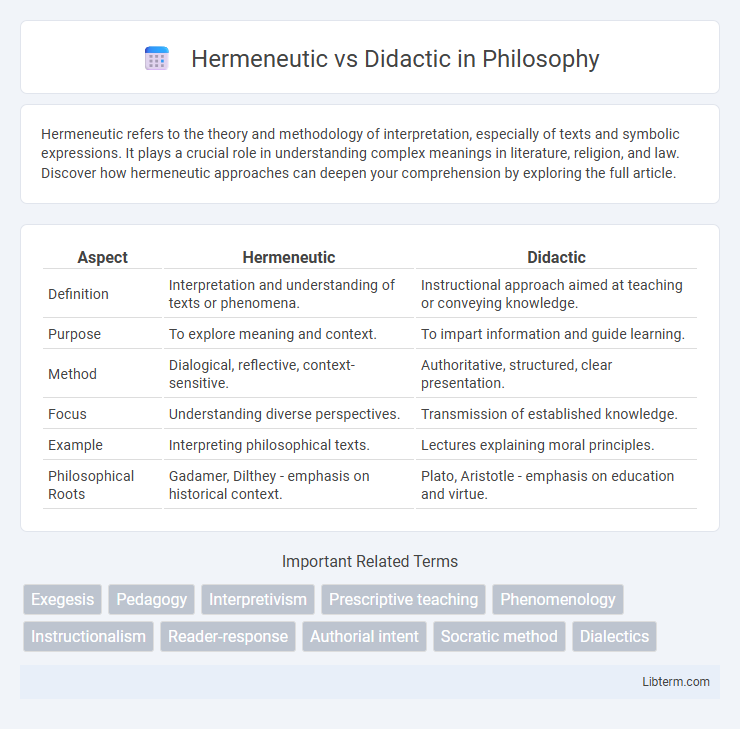Hermeneutic refers to the theory and methodology of interpretation, especially of texts and symbolic expressions. It plays a crucial role in understanding complex meanings in literature, religion, and law. Discover how hermeneutic approaches can deepen your comprehension by exploring the full article.
Table of Comparison
| Aspect | Hermeneutic | Didactic |
|---|---|---|
| Definition | Interpretation and understanding of texts or phenomena. | Instructional approach aimed at teaching or conveying knowledge. |
| Purpose | To explore meaning and context. | To impart information and guide learning. |
| Method | Dialogical, reflective, context-sensitive. | Authoritative, structured, clear presentation. |
| Focus | Understanding diverse perspectives. | Transmission of established knowledge. |
| Example | Interpreting philosophical texts. | Lectures explaining moral principles. |
| Philosophical Roots | Gadamer, Dilthey - emphasis on historical context. | Plato, Aristotle - emphasis on education and virtue. |
Introduction to Hermeneutic and Didactic Approaches
Hermeneutic approaches emphasize interpretation and understanding of texts, focusing on the meaning conveyed by language within its historical and cultural context. Didactic approaches prioritize instructional clarity and the transmission of knowledge, often aiming to teach specific lessons or morals. Both methods are essential in educational settings, with hermeneutics fostering critical thinking and didactics ensuring structured learning outcomes.
Defining Hermeneutic: Interpretation in Context
Hermeneutic refers to the process of interpreting texts or symbolic expressions within their specific historical, cultural, and situational contexts to uncover deeper meanings. It emphasizes understanding the intentions of the author, the audience's perspective, and the interplay between text and context in shaping interpretation. This approach contrasts with didactic methods, which prioritize direct teaching and explicit instructional content.
Defining Didactic: Instruction and Teaching
Didactic refers to instructional content designed primarily to educate or instruct learners through clear, methodical teaching methods. It emphasizes imparting knowledge, skills, or moral lessons in a structured and straightforward manner, often using lectures, textbooks, or direct explanations. This approach contrasts with hermeneutic methods, which focus on interpretation and understanding of meaning rather than solely delivering information.
Philosophical Foundations of Hermeneutics
Hermeneutics, rooted in the philosophical traditions of Heidegger and Gadamer, emphasizes the interpretation and understanding of texts through context, history, and the dialectical fusion of horizons. Unlike didactic methods that prioritize direct instruction and authoritative knowledge transmission, hermeneutics focuses on the dynamic and co-creative process of meaning-making between interpreter and text. This philosophical foundation asserts that understanding is not a mere reproduction of knowledge but an existential engagement shaped by preconceptions and lived experience.
The Educational Roots of Didactic Methods
Didactic methods in education originate from ancient pedagogical traditions emphasizing direct instruction and clear knowledge transmission. Rooted in classical rhetoric and Socratic teaching, these methods prioritize structured lessons and authoritative guidance to ensure students grasp core concepts effectively. Emphasizing clarity and memorization, didactic approaches contrast with hermeneutic methods, which focus on interpretation and critical thinking.
Key Differences Between Hermeneutic and Didactic
Hermeneutic approaches prioritize interpretation and understanding of meaning within texts or contexts, emphasizing context, subjectivity, and the dynamic nature of meaning. Didactic methods focus on instruction and conveying clear, fixed knowledge or moral lessons, aiming at direct teaching and learner compliance. The key differences lie in hermeneutic's open-ended exploration versus didactic's structured, authoritative communication.
Advantages of Hermeneutic Approaches
Hermeneutic approaches enhance understanding by emphasizing interpretation and context, enabling deeper engagement with texts or situations. This method fosters critical thinking and promotes multiple perspectives, accommodating complex meanings beyond surface-level information. By prioritizing dialogue and reflection, hermeneutics supports a more nuanced and adaptable learning process compared to rigid didactic instruction.
Benefits and Limitations of Didactic Teaching
Didactic teaching offers clear structure and efficient knowledge transfer, making complex information accessible through direct instruction and repetition. Its benefits include standardized content delivery and measurable learning outcomes, yet it often limits critical thinking and student engagement by emphasizing memorization over exploration. This approach may also reduce adaptability to diverse learning styles, potentially hindering deeper understanding and creativity.
Applications in Literature, Philosophy, and Education
Hermeneutic approaches emphasize interpreting texts and uncovering meaning, playing a crucial role in literature by analyzing symbolism and thematic depth, while in philosophy, they guide understanding of existential and ethical questions. Didactic methods prioritize instruction and clear moral or educational messages, influencing literature aimed at teaching lessons, philosophical texts that assert doctrines, and educational settings focused on knowledge transmission. In education, hermeneutics fosters critical thinking and interpretative skills, whereas didactic techniques ensure structured learning and mastery of specific content.
Choosing Between Hermeneutic and Didactic: Practical Considerations
Choosing between hermeneutic and didactic approaches depends on the learning goals and context; hermeneutic methods emphasize interpretation and critical thinking, ideal for exploring complex texts or fostering deep understanding. Didactic methods prioritize structured knowledge delivery and clear instructions, suitable for foundational learning or skill acquisition. Practical considerations include learner readiness, subject complexity, and desired engagement level to optimize teaching effectiveness.
Hermeneutic Infographic

 libterm.com
libterm.com